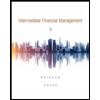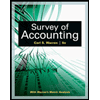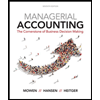,Match the following terms with the appropriate definition.Effective yield or interest rateMonetary liabilityCompound interestPresent ValueFuture value of a single amountA.Fixed obligation to pay an amount in cash.B.The rate at which money will actually grow.C.Interest accumulates on interest.D.Current worth of future cash flows.E.The money to which an amount invested will grow over time.
,Match the following terms with the appropriate definition.Effective yield or interest rateMonetary liabilityCompound interestPresent ValueFuture value of a single amountA.Fixed obligation to pay an amount in cash.B.The rate at which money will actually grow.C.Interest accumulates on interest.D.Current worth of future cash flows.E.The money to which an amount invested will grow over time.
Intermediate Financial Management (MindTap Course List)
13th Edition
ISBN:9781337395083
Author:Eugene F. Brigham, Phillip R. Daves
Publisher:Eugene F. Brigham, Phillip R. Daves
Chapter17: Dynamic Capital Structures And Corporate Valuation
Section: Chapter Questions
Problem 1Q
Related questions
Question
100%
,Match the following terms with the appropriate definition.
Effective yield or interest rate
Monetary liability
Compound interest
Present Value
Future value of a single amount
A.
Fixed obligation to pay an amount in cash.
B.
The rate at which money will actually grow.
C.
Interest accumulates on interest.
D.
Current worth of future cash flows.
E.
The money to which an amount invested will grow over time.
Expert Solution
This question has been solved!
Explore an expertly crafted, step-by-step solution for a thorough understanding of key concepts.
This is a popular solution!
Trending now
This is a popular solution!
Step by step
Solved in 2 steps with 1 images

Knowledge Booster
Learn more about
Need a deep-dive on the concept behind this application? Look no further. Learn more about this topic, accounting and related others by exploring similar questions and additional content below.Recommended textbooks for you

Intermediate Financial Management (MindTap Course…
Finance
ISBN:
9781337395083
Author:
Eugene F. Brigham, Phillip R. Daves
Publisher:
Cengage Learning


Principles of Accounting Volume 2
Accounting
ISBN:
9781947172609
Author:
OpenStax
Publisher:
OpenStax College

Intermediate Financial Management (MindTap Course…
Finance
ISBN:
9781337395083
Author:
Eugene F. Brigham, Phillip R. Daves
Publisher:
Cengage Learning


Principles of Accounting Volume 2
Accounting
ISBN:
9781947172609
Author:
OpenStax
Publisher:
OpenStax College

Survey of Accounting (Accounting I)
Accounting
ISBN:
9781305961883
Author:
Carl Warren
Publisher:
Cengage Learning

Managerial Accounting: The Cornerstone of Busines…
Accounting
ISBN:
9781337115773
Author:
Maryanne M. Mowen, Don R. Hansen, Dan L. Heitger
Publisher:
Cengage Learning
